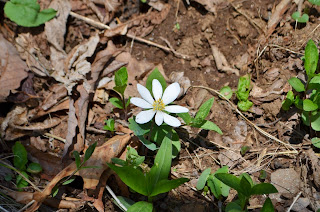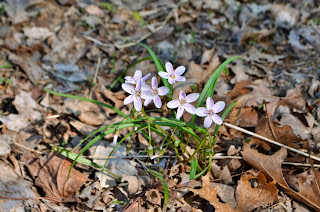Saturday, we headed up to Rocky Knob Recreation Area off the Blue Ridge Parkway in Virginia for a wildflower hike. The Rock Castle Gorge Trail, a National Recreation Trail, makes an 11-mile loop with great wildflower viewing opportunities. We left the Chapel Hill area around 7 and made the drive up, arriving at the parking area off CC Camp Road around 930. Surprisingly, there were quite a few cars here and we had some trouble finding a place to park. In past years, there was never more than one or two cars parked here - a good thing since there isn’t much room. But apparently, this place is getting more popular and we had to really squeeze the cars in. Once everyone was ready, we started off on the trail, turning right after crossing the bridge to hike the loop in the clockwise direction. Although its possible to start the trail from up on the Blue Ridge Parkway, starting at the bottom and hiking clockwise allows getting the hardest part of the trail out of the way at the beginning. After the steep climb up, the rest of the trail feels like a walk in the park. The trail follows Little Rock Castle Creek upstream for a ways and begins to get really steep as the trail departs from the creek. We saw a few trillium and other wildflowers on the way, which provided a much-appreciated opportunity to stop and take a break.
There are also several scenic spots where the trail crosses small feeder streams and overlooks where we could take a quick break. Although the foliage was starting to come in on the trees, it was still open enough to have good views of the gorge below. Although this part of the trail is the most challenging, we were still fresh from just starting our hike and soon the trail leveled off as it approached the parkway. Once out of the woods, the trail runs through an open area running parallel to the parkway where cows were grazing.
We continued up and over the bald and came to the Saddle Overlook, where we had views of the gorge below and Buffalo Mountain, a conspicuous hump-shaped mountain, in the opposite direction.
From here, we went back into the woods, climbing up Rocky Knob, the highpoint in the recreation area.
Just past the old AT shelter is a nice overlook, where we stopped to eat lunch. The Appalachian Trail once went through this area, but was rerouted for the Blue Ridge Parkway. After lunch, we continued on the trail, down from Rocky Knob to the Rock Castle Gorge overlook and on towards Grassy Knoll.
The trail runs through several areas where cows graze and there are several ladders to climb over the fences that contain the cows.
One stretch of barbed-wire fence, however, did not have a ladder to cross. It wasn’t very high, so easy enough to cross without the fence, but it could be dangerous if someone didn’t see it. After Grassy Knoll, we started to head back down into the gorge. Hiking through the last open area before the gorge, we saw a large herd of cows grazing, including several calves.
This is normally a nice breaking point, but we had to move a bit so as to not bother the cows. After this point, we started making our descent into Rock Castle Gorge. The wildflowers were tremendous in this area.
We saw hillsides of red, violet, and white trillium, along with jack-in-the-pulpits, Dutchman’s breeches, bloodroot, violets, and others.
We definitely picked a good weekend for the hike as the flowers were in peak bloom and were absolutely gorgeous.
The hike down into the gorge actually took longer than the strenuous hike up because we were stopping so frequently to see the flowers.
Near the bottom, we stopped for a break at the “Rock Castle”, a large pile of enormous boulders.
The gorge’s name comes from the shape of certain rocks in the gorge that resemble castle towers, though I’ve never seen these here. Despite that, the large boulder pile along the trail is sometimes referred to as the Rock Castle. Past here, the trail crosses Rock Castle Creek and heads back along an old road to the parking area.
We saw a lot of violets, a few jack-in-the-pulpits, and some other wildflowers, but not the trillium that were so prevalent further up the trail.
We passed the Austin House and crossed the creek several times on footbridges, before making it back to the parking area.
As we were packing up the cars and getting ready to leave, we saw a few flowers in bloom right next to the car that hadn’t been blooming when we started.
A couple of dwarf-crested irises had started to bloom while we were hiking! On the way back, we stopped for pizza and beer at Radius Pizzeria and Pub in Hillsborough.
Saturday, April 26, 2014
Saturday, April 12, 2014
Wildflowers in Penny's Bend
After a long winter, spring is finally here. To celebrate the nice weather, I headed to Penny's Bend Nature Preserve in Durham. This small preserve on a horseshoe bend in Eno River is one of the best places in the Triangle area to see wildflowers. Arriving at the preserve, the parking lot was full and I had to park along the street. Luckily, most of these people were here fishing in the river and I wouldn't have to worry about crowds on my hike.
I started out on the George Pyne Trail that runs parallel to the river.
Almost immediately, I could see an explosion of color along the trail with wildflowers in blue, white, and pink carpeting the forest floor next to me.
It was a beautiful sight and I stopped frequently to capture some pictures of the spring ephemerals.
Further along, near the northwest end of the preserve, I started seeing patches of Dutchman's breeches, a really neat little flower.
I also saw a big rock with a crack down the middle. Out of the crack were growing several little clumps of Spring Beauty.
The number of wildflowers on this short little section of trail was spectacular.
I took the loop up through an open area and back down to the parking lot and then headed across Old Oxford Highway to Section 23 of the Falls Lake Trail.
There's a new campsite along this section of the trail. A private landowner is nice enough to allow hikers to camp on his land and I wanted to check it out. So I hiked about 3 miles east on Section 23 to the well-marked turn onto a blue-blazed spur trail. The spur trail led through a pine forest to an open area with a shelter, fire pits, and flat ground for tents.
It was a really nice campsite and it's extremely nice of the landowner to allow people to camp here. As I was heading back on the Falls Lake Trail, I noticed a few wildflowers, but nothing like the amount in Penny's Bend. It's amazing what a difference in flora, despite these areas being so close.
I started out on the George Pyne Trail that runs parallel to the river.
Almost immediately, I could see an explosion of color along the trail with wildflowers in blue, white, and pink carpeting the forest floor next to me.
It was a beautiful sight and I stopped frequently to capture some pictures of the spring ephemerals.
Further along, near the northwest end of the preserve, I started seeing patches of Dutchman's breeches, a really neat little flower.
I also saw a big rock with a crack down the middle. Out of the crack were growing several little clumps of Spring Beauty.
The number of wildflowers on this short little section of trail was spectacular.
I took the loop up through an open area and back down to the parking lot and then headed across Old Oxford Highway to Section 23 of the Falls Lake Trail.
There's a new campsite along this section of the trail. A private landowner is nice enough to allow hikers to camp on his land and I wanted to check it out. So I hiked about 3 miles east on Section 23 to the well-marked turn onto a blue-blazed spur trail. The spur trail led through a pine forest to an open area with a shelter, fire pits, and flat ground for tents.
It was a really nice campsite and it's extremely nice of the landowner to allow people to camp here. As I was heading back on the Falls Lake Trail, I noticed a few wildflowers, but nothing like the amount in Penny's Bend. It's amazing what a difference in flora, despite these areas being so close.
Subscribe to:
Comments (Atom)

























